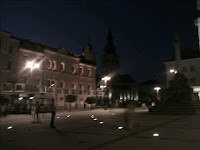




During our stay in Frankfurt and, mainly, Kassel, we needed the time to adapt. As a result, we slept a great deal, and much of that time during the day. Of course, things got much better by the time we left. The weather was pretty nice, with high temperatures around the low to mid-20s, and very little rain during the day.
On August 11, we boarded a very early train to Frankfurt Airport, hung out for a few hours waiting for our flight to Vienna, and then spent about 3 and a half hours on the plane. After that, it got hectic. We "fortunately" were able to get on a bus to Bratislava within half an hour, and then again had about 20 minutes to board another bus to Banská Bystrica in Central Slovakia. I used quotations marks because, although it meant timely connections, it also became a major rush, piling one leg of the trip on top of another. Bathroom and meal opportunities were highly limited. By the time we arrived at our hotel, it was evening, and we were tired, hungry, and grouchy. In hindsight, we agreed to split up the journey next time. A relaxing night in Vienna would have been much better, although we had already booked the hotel in BB and would have had to make a change.
The transition was also hard in other other ways. First, the urban landscape changed, as Slovakia is not quite yet in the position to have everything new, sparkling, or restored the way it seems to be in Germany. Thus, dust, decay, gray colours, and graffiti were a bit more evident as we moved in and out of Bratislava, and then into Banská Bystrica. Secondly, our roles in the cultural and lingusitic arena were now completely reversed: I know about ten words in Slovak, and within a day became almost completely dependent on Stefan, who proceded to move along at a fast pace while I struggled with my overpacked luggage (another urgent lesson to learn, AGAIN: pack light!). We ended up sleeping away our tiredness and glum moods for another day. Then things brightened up again. Note: Sleep definitely helps.
Banská Bystrica is quite pretty--actually beautiful in places--with lots of history seeping out all over the town and the region. We came here because Stefan was born here and has extended family.
The town itself was designated as such in the thirteenth century, with economy built mainly (and literally) on mining. The principal ore had been copper, but there was also silver and some gold. These two other ores were more prominent in the two "sister" towns of Banská (that means "mining") Štiavnica (silver) and Kremnica (gold). Most of the mining activity took place from the 13th to 18th centuries.
Early on, I took some nighttime shots of the main, market square, the Námestie Slovenkého Národného Postvania. (Now you see what I mean about the language.) It means Square of Slovak National Uprising. And what did they rise up against? The Nazi Germans, or fascists, in 1944! Talk about another side of history, and the views deriving thereof. Not that other nations hadn't invaded Slovakia before (e.g., Hungarians) and after (Russians), but of course this chapter, still in some living memory and displayed in museums and memorials, stands out somewhat. There didn't seem to have been as much resistance to other conquests. In fact, prior to 1944, there was little agitation against the Germans, either.
There were a few days when I did not have the time and/or energy to post, but now I'm working hard on catching up. More to come.





















































